Exotic, but established
Cnephasia longana (Haworth) (Tortricidae: Tortricinae: Cnephasiini)
Common names: omnivorous leaf-tier, strawberry fruitworm
Synonyms: cadizensis (form), capillana (Sphaleroptera), egenana (Tortrix), expallidana (Tortrix), gratana (Sciaphila), ictericana (Tortrix), insolatana (Tortrix), loeviana (Sciaphila), luridalbana (Tortrix), lutosana (Tortrix), minor (form), ongana (Cnephasia), stratana (Sciaphila)
FWLFWL:
forewing length; the distance from the base of the forewing to the apex, including fringe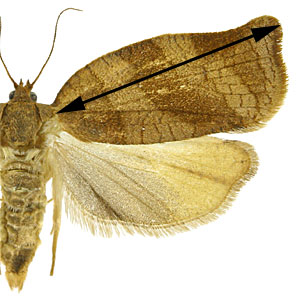 : 7.5-10.8 mm
: 7.5-10.8 mm
Cnephasia longana is sexually dimorphic: males are a uniform white to yellowish brown while females are variably marked with light to dark brown. Some females have a strong fasciatefasciate:
a wing pattern that is comprised primarily of transverse bands (fasciae) 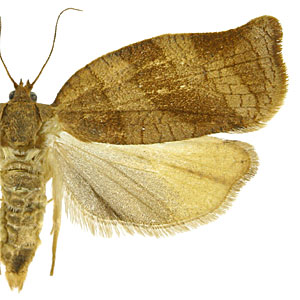 pattern. Males lack a forewing costal foldforewing costal fold:
pattern. Males lack a forewing costal foldforewing costal fold:
a flap or fold at the base of the forewing that contains specialized sex scales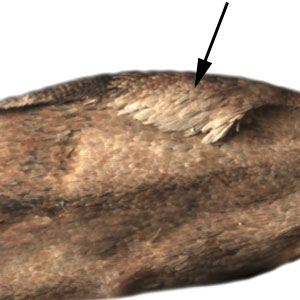 .
.
Male genitalia are characterized by an elongate, triangular, minutely spined uncusuncus:
a sclerotized process which is fused to the posterodorsal margin of tergum IX ; narrow, setosesetose:
; narrow, setosesetose:
covered with setae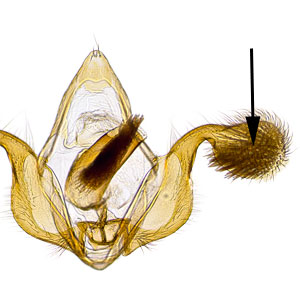 sociisocii:
sociisocii:
a pair of lightly sclerotized setose lobes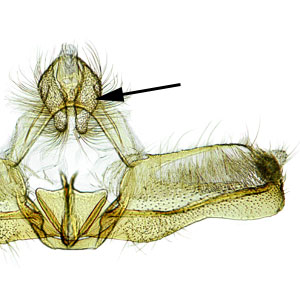 ; and elongate valvaevalva:
; and elongate valvaevalva:
an appendage flanking the intromittent organ that is used to clasp the female during copulation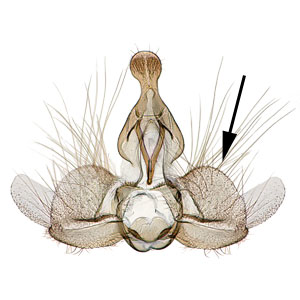 with a well-developed sacculussacculus:
with a well-developed sacculussacculus:
the ventral margin of the male valva  . Female genitalia are characterized by unusual, modified papillae analespapillae anales:
. Female genitalia are characterized by unusual, modified papillae analespapillae anales:
the female ovipositor lobes 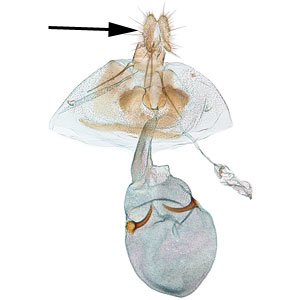 ; a short ductus bursaeductus bursae:
; a short ductus bursaeductus bursae:
a membranous tube connecting the ostium bursae to the corpus bursae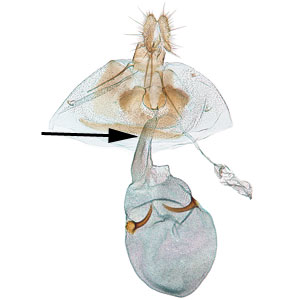 ; and a narrow row of minute spine-like scobinations in the corpus bursaecorpus bursae:
; and a narrow row of minute spine-like scobinations in the corpus bursaecorpus bursae:
a dilated membranous sac at the anterior end of the bursa copulatrix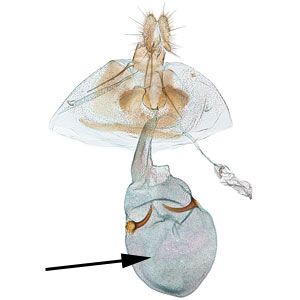 .
.
The following account is summarized from Swatschek (1958)Swatschek (1958):
Swatschek, B. 1958. Die larval systematik der wickler (Tortricidae und Carposinidae) aus dem zoologischen Institut der Universitat Erlangen. Akademie-Verlag, Berlin. 269 pp. [Abhandlungen zur larvalsystematik Insekten 3.].
Late instar larvae are greenish brown or yellowish green with pale laterallateral:
to the side lines and are approximately 14-18 mm in length. The head is pale brown with dark brown margins and the prothoracic shieldprothoracic shield:
lines and are approximately 14-18 mm in length. The head is pale brown with dark brown margins and the prothoracic shieldprothoracic shield:
a sclerotized plate on the dorsal surface of the prothorax 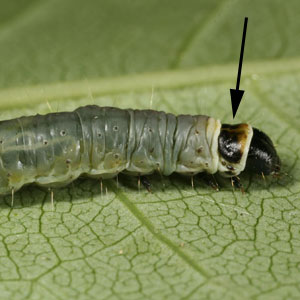 is concolorous with the rest of the body.
is concolorous with the rest of the body.
The yellowish, narrow, elongate forewings separate this species from most of the other Tortricidae covered on this site. Other Palearctic Cnephasia, such as C. gueneeana, are similar; a genitalic dissection can be used to confirm identity.
The following account is summarized from Edwards & Mote (1936) and Cram & Tonks (1959).
Adults are present from late March to early July in North America. Females lay eggs singly or in small batches in depressions or cracks in the bark of trees and cover them with bits of debris. After hatching, first instar larvae search out suitable cracks or crevices in bark, construct a silk hibernaculum, and hibernate for the remainder of the summer and following winter. Larvae leave the hibernaculum in the spring and disperse to nearby herbaceous plants by ballooning with the aid of silk threads. After encountering a suitable host, larvae mine within leaves close to the ground. Later instars web terminal parts of the plant, including the shoots, buds, and/or flowers. In some instances, larvae may bore into fruit (such as strawberries) causing economic damage.
Cnephasia longana larvae have been recorded feeding on many herbaceous plants. In Europe, the larvae can be a pest of cereal crops. In Oregon and Washington, C. longana larvae have been reported as a pest of strawberries. The following host list contains plants in more than 20 families.
| Host plant | Host plant family | Reference(s) |
| Selinum carvifolium | Apiaceae | Bradley et al. 1973Bradley et al. 1973: Bradley, J. D., Tremewan, W. G., Smith, A. 1973. British Tortricoid Moths, Cochylidae and Tortricidae: Tortricinae. The Ray Society, London. 251 pp. |
| Achillea millefolium | Asteraceae | Powell 2006Powell 2006: Powell, J. A. 2006. Database of Lepidoptera rearing lots, 1960-2005. University of California Berkeley, CA. |
| Achillea sp. | Asteraceae | Powell 2006Powell 2006: Powell, J. A. 2006. Database of Lepidoptera rearing lots, 1960-2005. University of California Berkeley, CA. |
| Agoseris heterophylla | Asteraceae | Powell 2006Powell 2006: Powell, J. A. 2006. Database of Lepidoptera rearing lots, 1960-2005. University of California Berkeley, CA. |
| Anthemis cotula | Asteraceae | MacKay 1962aMacKay 1962a: MacKay, M. R. 1962a. Larvae of the North American Tortricinae (Lepidoptera: Tortricidae). Canadian Entomologist, Supplement 28: 1-182. |
| Anthemis sp. | Asteraceae | Bradley et al. 1973Bradley et al. 1973: Bradley, J. D., Tremewan, W. G., Smith, A. 1973. British Tortricoid Moths, Cochylidae and Tortricidae: Tortricinae. The Ray Society, London. 251 pp. |
| Aster sp. | Asteraceae | Meyrick MS 1938Meyrick MS 1938: Meyrick MS 1938. Unpublished manuscript by E. Meyrick at BMNH, data captured by Gaeden Robinson. |
| Centaurea sp. | Asteraceae | Disque 1908Disque 1908: Disque, H. 1908. Versuch einer microlepidopterologischen Botanik. Deutsch Entomologische Zeitschrift Iris. 21: 34-147. |
| Chrysanthemum sp. | Asteraceae | MacKay 1962aMacKay 1962a: MacKay, M. R. 1962a. Larvae of the North American Tortricinae (Lepidoptera: Tortricidae). Canadian Entomologist, Supplement 28: 1-182.; Bradley et al. 1973Bradley et al. 1973: Bradley, J. D., Tremewan, W. G., Smith, A. 1973. British Tortricoid Moths, Cochylidae and Tortricidae: Tortricinae. The Ray Society, London. 251 pp. |
| Cirsium sp. | Asteraceae | MacKay 1962aMacKay 1962a: MacKay, M. R. 1962a. Larvae of the North American Tortricinae (Lepidoptera: Tortricidae). Canadian Entomologist, Supplement 28: 1-182. |
| Erigeron glaucus | Asteraceae | Powell 2006Powell 2006: Powell, J. A. 2006. Database of Lepidoptera rearing lots, 1960-2005. University of California Berkeley, CA. |
| Hypochaeris sp. | Asteraceae | Ford 1949Ford 1949: Ford, L. T. 1949. A guide to the smaller British Lepidoptera. South London Entomological and Natural History Society, London, England. 230 pp. |
| Leucanthemum vulgare | Asteraceae | MacKay 1962aMacKay 1962a: MacKay, M. R. 1962a. Larvae of the North American Tortricinae (Lepidoptera: Tortricidae). Canadian Entomologist, Supplement 28: 1-182. |
| Ligularia sp. | Asteraceae | Bradley et al. 1973Bradley et al. 1973: Bradley, J. D., Tremewan, W. G., Smith, A. 1973. British Tortricoid Moths, Cochylidae and Tortricidae: Tortricinae. The Ray Society, London. 251 pp. |
| Senecio jacobaea | Asteraceae | Frick & Hawkes 1970 |
| Sonchus arvensis | Asteraceae | Meyrick MS 1938Meyrick MS 1938: Meyrick MS 1938. Unpublished manuscript by E. Meyrick at BMNH, data captured by Gaeden Robinson. |
| Tripolium pannonicum | Asteraceae | MacKay 1962aMacKay 1962a: MacKay, M. R. 1962a. Larvae of the North American Tortricinae (Lepidoptera: Tortricidae). Canadian Entomologist, Supplement 28: 1-182.; Bradley et al. 1973Bradley et al. 1973: Bradley, J. D., Tremewan, W. G., Smith, A. 1973. British Tortricoid Moths, Cochylidae and Tortricidae: Tortricinae. The Ray Society, London. 251 pp. |
| Wyethia angustifolia | Asteraceae | De Benedictis et al. 1990De Benedictis et al. 1990: De Benedictis, J. A., Wagner, D. L., Whitfield, J. B. 1990. Larval hosts of Microlepidoptera of the San Bruno Mountains, California. Atala. 16: 14-35.; Powell 2006Powell 2006: Powell, J. A. 2006. Database of Lepidoptera rearing lots, 1960-2005. University of California Berkeley, CA. |
| Mahonia pinnata | Berberidaceae | Powell 2006Powell 2006: Powell, J. A. 2006. Database of Lepidoptera rearing lots, 1960-2005. University of California Berkeley, CA. |
| Amsinckia menziesii var. intermedia | Boraginaceae | Powell 2006Powell 2006: Powell, J. A. 2006. Database of Lepidoptera rearing lots, 1960-2005. University of California Berkeley, CA. |
| Amsinckia sp. | Boraginaceae | Powell 2006Powell 2006: Powell, J. A. 2006. Database of Lepidoptera rearing lots, 1960-2005. University of California Berkeley, CA. |
| Lychnis |
View full screen host table here
Cnephasia longana is native to the Palearctic where it is widely distributed across Europe, northwestern Africa, and Asia. It was first collected in western North America in Oregon in the late 1920s (Edwards & Mote 1936) and is currently present from southern British Columbia south to California.